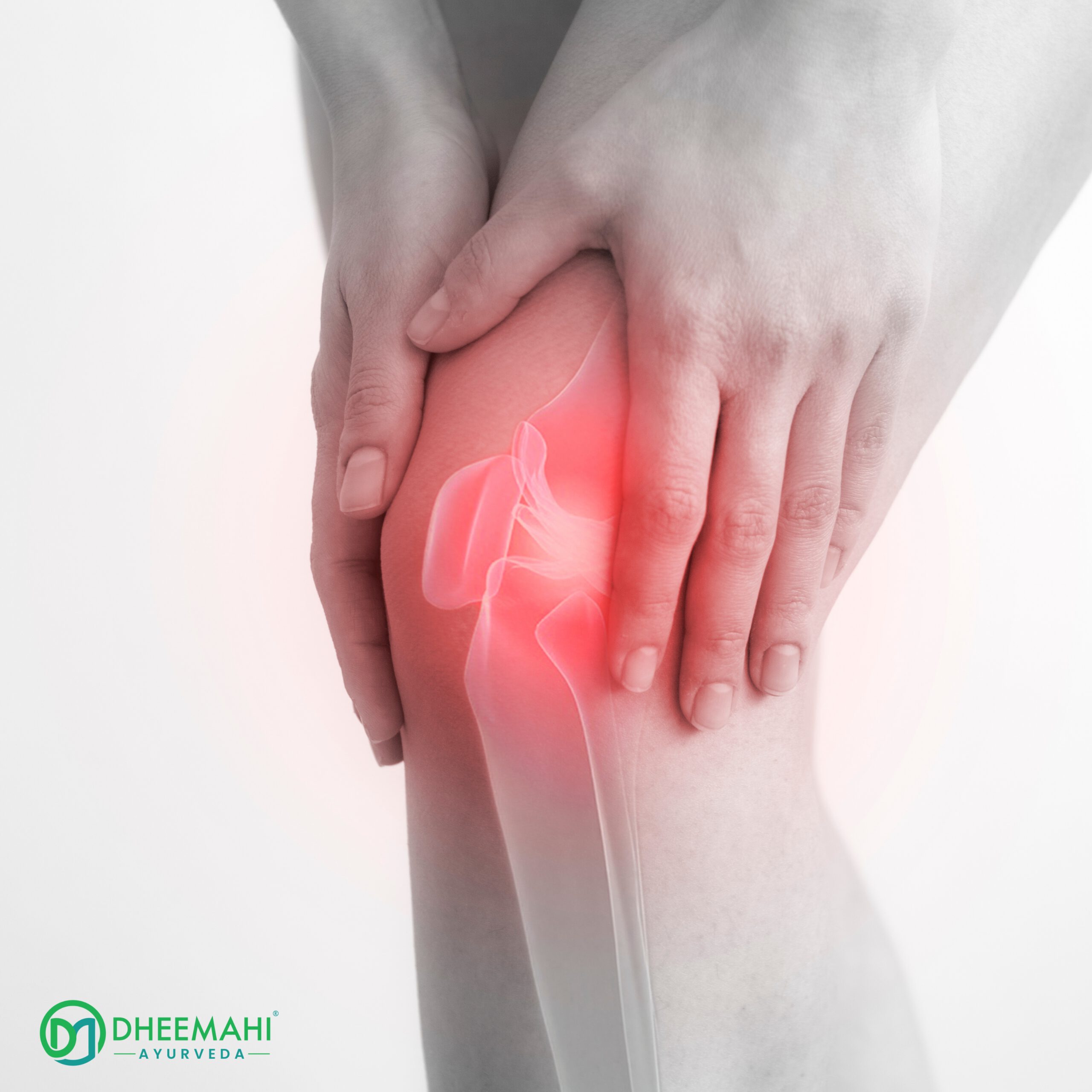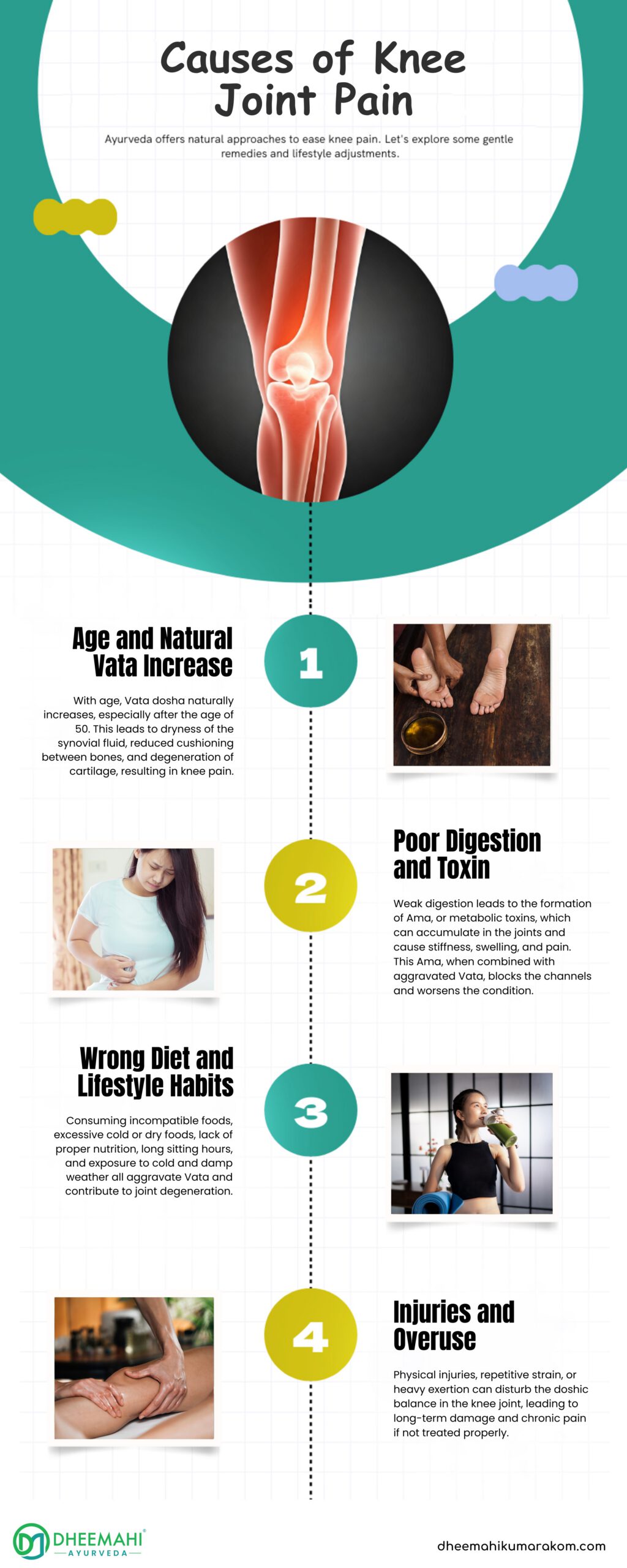How to Manage Knee Joint Pain with Ayurveda
Knee joint pain is a common issue that affects people across all age groups, especially with today’s sedentary lifestyles, poor postures, and age-related degeneration. Whether it arises from osteoarthritis, rheumatoid arthritis, injury, or overuse, the pain and stiffness can severely limit mobility and reduce quality of life.
While conventional treatments often rely on painkillers or surgical interventions, these do not always address the root cause and may come with side effects. Ayurveda, the ancient Indian system of medicine, offers a holistic and personalized approach to managing knee joint pain, aiming to eliminate the underlying imbalance rather than merely suppressing symptoms.
At Dheemahi Ayurvedic Village, we focus on delivering doctor-led, individualized treatments that combine authentic Ayurvedic principles with practical, long-term relief. In this guide, you’ll discover how knee joint pain Ayurveda protocols work, and how Ayurveda treatment for joint pain can provide safe, effective, and lasting relief.
Understanding Knee Joint Pain in Ayurveda
In Ayurveda, joint pain is broadly categorized under a condition called Sandhivata, which arises primarily due to the aggravation of Vata dosha. Vata controls all movement in the body, including how your joints move. When Vata becomes imbalanced due to age, stress, diet, or weather, it leads to dryness, degeneration, and pain in the joints especially the knees.
However, not all joint pain is the same. Ayurveda identifies different root causes for knee pain:
- Vata-related pain: Feels dry, accompanied by cracking or popping sounds, stiffness, and pain that worsens in cold conditions.
- Pitta-dominant pain: Inflammation, swelling, burning sensation, and redness.
- Kapha-dominant pain: Heaviness, swelling, fluid retention, and sluggish movement.
Ayurvedic diagnosis considers the prakriti (body constitution) and the nature of the imbalance to design a treatment plan that targets the cause, not just the symptoms.
Causes of Knee Joint Pain from an Ayurvedic Perspective
1. Age and Natural Vata Increase
With age, Vata dosha naturally increases, especially after the age of 50. This leads to dryness of the synovial fluid, reduced cushioning between bones, and degeneration of cartilage, resulting in knee pain.
2. Poor Digestion and Toxin Accumulation (Ama)
Weak digestion leads to the formation of Ama, or metabolic toxins, which can accumulate in the joints and cause stiffness, swelling, and pain. This Ama, when combined with aggravated Vata, blocks the channels and worsens the condition.
3. Wrong Diet and Lifestyle Habits
Consuming incompatible foods, excessive cold or dry foods, lack of proper nutrition, long sitting hours, and exposure to cold and damp weather all aggravate Vata and contribute to joint degeneration.
4. Injuries and Overuse
Physical injuries, repetitive strain, or heavy exertion can disturb the doshic balance in the knee joint, leading to long-term damage and chronic pain if not treated properly.
Signs and Symptoms of Knee Joint Imbalance
- Pain that increases in the morning or evening
- Difficulty in walking, climbing stairs, or squatting
- Stiffness after periods of inactivity
- Swelling around the knee
- Audible cracking or clicking sounds
- Sensitivity to cold or damp weather
- Reduced flexibility or range of motion
If these symptoms persist, it’s important to address them early using natural and non-invasive approaches such as Ayurveda treatment for joint pain.
Ayurvedic Treatment for Knee Joint Pain
Ayurvedic treatment doesn’t offer a “quick fix”-it offers deep, root-cause healing. Here’s how knee joint pain Ayurveda protocols are typically structured:
1. Shodhana – Detoxification and Dosha Elimination
If the pain is caused by Ama or dosha accumulation, Panchakarma therapies are advised to eliminate these toxins from the body and restore balance.
Common Panchakarma therapies used for knee joint pain include:
- Virechana (Purgation therapy): Cleanses excess Pitta and inflammation.
- Basti (Medicated enema): The most effective treatment for Vata disorders, especially chronic joint pain.
- Abhyanga (Oil massage): Nourishes and lubricates the joints, reducing stiffness and dryness.
- Swedana (Herbal steam therapy): Helps open up blocked channels and reduce Ama.
Each therapy is prescribed only after careful medical evaluation and is performed under the supervision of experienced Ayurvedic physicians.
2. Shamana – Pacifying and Strengthening Treatments
After detoxification, the next step is to soothe the doshas and strengthen the affected joints. This involves:
- Specific herbal formulations for joint lubrication, anti-inflammation, and cartilage nourishment
- Internal medicines that improve Agni and reduce Ama formation
- Natural calcium sources (only when indicated and tailored to patient)
Important: Dheemahi Ayurveda does not generalize or promote over-the-counter solutions. All medicines are prescribed only after proper diagnosis.
3. Dietary Guidance for Joint Health
A well-regulated diet is crucial for reducing joint pain and supporting long-term healing.
- Favor warm, freshly cooked foods with good moisture content
- Avoid dry, raw, stale, and fermented items
- Include anti-inflammatory herbs like turmeric (when recommended)
- Drink warm water to enhance Agni and support detox
- Avoid sour, fried, and processed foods that increase inflammation
Eating according to your dosha and digestive capacity is a cornerstone of Ayurveda treatment for joint pain.
4. Lifestyle and Physical Activity Recommendations
Ayurveda emphasizes balanced movement. While excessive strain worsens joint conditions, complete inactivity also causes stagnation.
- Practice gentle yoga poses like Vrikshasana, Tadasana, and Bhujangasana
- Avoid weight-bearing exercises during pain flare-ups
- Maintain proper posture while sitting, standing, and walking
- Use warm compresses during cold weather to prevent Vata aggravation
- Practice dinacharya (daily routine) for consistency and healing rhythm
5. Rasayana Therapy (Rejuvenation) for Long-Term Joint Health
After detox and symptom relief, Ayurveda offers rasayana chikitsa-a rejuvenative phase focused on:
- Rebuilding cartilage
- Nourishing joint tissues
- Enhancing bone strength
- Improving energy and immunity
This phase is essential in preventing relapse and ensuring sustained relief from knee joint pain.
How Ayurveda Helps Prevent Surgery
One of the most appreciated aspects of knee joint pain Ayurveda management is that it often prevents the need for surgery. Many patients who were advised knee replacements have found lasting relief through Ayurvedic therapies, provided the treatment is started early and followed consistently.
The goal is to:
- Slow or reverse joint degeneration
- Improve lubrication and mobility
- Reduce inflammation without side effects
- Strengthen supportive tissues naturally
Why Choose Dheemahi Ayurveda for Joint Pain Treatment?
At Dheemahi Ayurveda Village, we believe in classical Ayurvedic practice with modern relevance. Every treatment is delivered under doctor supervision and is customized to each patient’s unique condition.
Here’s what makes us different:
- Doctor-Led Care: Your condition is evaluated by qualified Ayurvedic physicians.
- Tailored Panchakarma: Only prescribed based on your body type and doshic imbalance.
- Safe Herbal Protocols: No over-the-counter advice every remedy is monitored.
- Follow-Up and Support: Consistent follow-up ensures recovery and relapse prevention.
- Holistic Approach: We treat the joint, the body, and the mind together.
Conclusion
Knee joint pain doesn’t just affect your mobility it affects your independence, your confidence, and your quality of life. Whether it’s a result of aging, arthritis, injury, or inflammation, ignoring the signs or depending solely on temporary solutions like painkillers can often lead to further deterioration.
Ayurveda offers more than just pain relief. It offers restoration. By identifying the root cause be it aggravated Vata, accumulated toxins, poor digestion, or lifestyle imbalances Ayurvedic treatment empowers the body to heal itself through time-tested therapies, tailored diets, natural medicines, and sustainable lifestyle corrections.
At Dheemahi Ayurveda Village, we believe that healing is personal. That’s why every treatment protocol is uniquely crafted by expert Ayurvedic doctors to suit your constitution, the stage of your condition, and your life context. Whether you’re in the early stages of joint discomfort or have been battling chronic knee pain for years, we provide doctor-led, personalized Ayurvedic care designed to reduce pain, improve mobility, and restore strength without side effects or unnecessary surgical interventions.
Don’t let joint pain define your daily life. Let Ayurveda show you a path of gentle yet powerful healing. With the right combination of Panchakarma therapies, internal medicines, diet guidance, and rejuvenation practices, lasting relief and mobility are possible.
Begin your journey to wellness with expert guidance in holistic Ayurvedic care, tailored treatments, and natural healing solutions
How Our Booking Process Works
The unique approach involves a series of discussion during your initial decision-making process to make sure that we will be able to match your expectations with our treatment.
Based on the discussions with you our team of expert doctors will design the best treatment package personalized for your needs.
01
Consultation Form
Fill out our consultation form, and let us know when will you be available for our doctor to talk to you
02
Discussion with Doctor
Discuss your health condition and expectations with our doctor.
03
Booking Confirmation
Confirm the booking by making a payment of 50% advance.
Consultation Form
Submit this form to initiate a booking with us
Have any queries? We will help you. Talk to us now
Say Goodbye to Health Woes & Hello to Healthy Living
Dheemahi Ayurvedic Pvt Ltd
12/386 Varaputhara Road
Kumarakom, Kerala, India
Pin 686563
Dheemahi Ayurvedic Centre, Near Neelimangalam Bridge, Kumaranaloor, Perumbaikad.P.O, Kottayam, Kerala, India, Pin 686016
Other Treatments
Karkidaka Chikilsa | Ayurvedic Treatment for Depression | How to Reduce Stress Naturally | Autoimmune Disorders | Mental Health Ayurvedic Treatment | Weight-Loss Treatment | Frozen Shoulder Ayurvedic Treatment | Diabetes Ayurvedic Treatment | PCOS Ayurvedic Treatment | Celiac Disease Treatment | ayurvedic treatment for skin diseases | nervous system ayurvedic treatment | Back Pain Ayurvedic Treatment | Cervical Spondylitis Ayurvedic Treatment | ayurvedic treatment for blood sugar | Fatty Liver Ayurvedic Treatment | Knee Pain Ayurvedic Treatment | Migraine Ayurvedic Treatment | Osteoarthritis Ayurvedic Treatment | Psoriasis Ayurvedic Treatment | Sinusitis Ayurvedic Treatment | Ayurvedic Detox Treatment | Migraine Ayurvedic Treatment | Ayurvedic Treatment for Rheumatoid Arthritis | Ayurvedic treatment for joint pain | Ayurvedic treatment for ulcerative colitis | Panchakarma Treatment |


